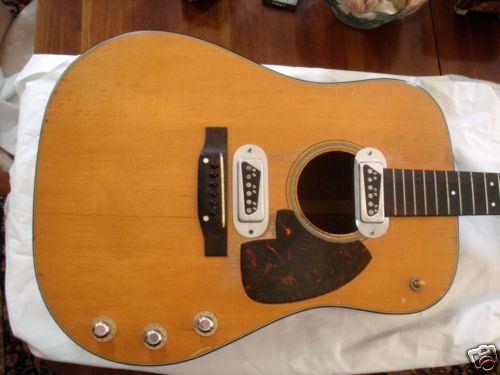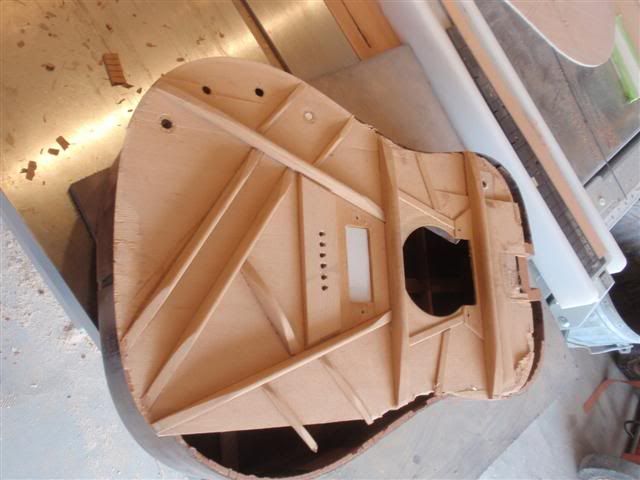
 |
|
#1
|
|||
|
|||
|
Ok first off I know this is probably incredibly stupid and could ruin the sound of the guitar BUT I have nice guitars that sound lovely and that's not what this project is about. My intention is to recreate the look of a rare Martin D18E and still have the guitar playable and OK sounding but doesn't have to have amazing bass or sustain etc...
I'm halfway there as I have all the ingredients. I managed to find some parts from an original D28E and I have a vintage Takamine D18 copy that I picked up fairly cheap. I need to convert it from X-bracing to a ladder brace set up to accommodate the guitar pick ups that will be fitted to the soundboard. Here is a picture of the guitar I want to recreate.  I'd love to buy the real deal but they are very rare and I could never afford one. Here is what I need to top bracing to look like  Could anyone offer me any advice on how to tackle this? Is it completely crazy or is it possible to remove the back of the guitar and remove some of the braces and replace them with new ones and then add the parts? Ideally I wanted to find a luthier to take it on but they all seem to not understand what I want to do / turn their nose up. |
|
#2
|
|||
|
|||
|
Quote:
__________________
---- Ned Milburn NSDCC Master Artisan Dartmouth, Nova Scotia Last edited by Ned Milburn; 01-22-2013 at 08:30 PM. Reason: Removed photos from original post. |
|
#3
|
|||
|
|||
|
Quote:
Interesting project. I believe that is the most heavily-braced Martin ever made. I'm sure it was to prevent feedback.
__________________
gits: good and plenty chops: snickers |
|
#4
|
|||
|
|||
|
Quote:
 Would it be better to remove the top? |
|
#5
|
|||
|
|||
|
Here's a picture of the guitar and parts just to give an idea of how accurate it could look.

|
|
#6
|
|||
|
|||
|
If the pickup wire and other depth doesn't bump into the x braces, you could potentially modify the guitar (ie: add the pickups) without changing the bracing. Also, even if you have to take a cm or so off of the x-braces in a limited area to allow for the pickup depth, you could potentially add a splice beam to the x-braces to bridge the removed area. This would likely be the most efficient way to do the project.
If you are ever close to Nova Scotia, I'd be happy to do a project like that for you, but I'm likely very far from you. You'll also likely find a local guy to do the project for you, but you have to understand that once the back comes off, it costs a LOT of money to do it this way (if you hire someone to do it for you) because the refitting, rebinding, and refinishing take a lot of time and care to do well. Splicing/bridging the x-braces, after thinking more about your project, seems to be the least invasive and most efficient and effective way to do the modification, but it depends where the pickups fall on the x-braces whether it is a practical option or not. Whoever you hire for the project, make sure you find a quality craftsman for this, since it would be a shame to have someone botch the job. It requires a craftsman who is creative and able to think "outside the box", so to speak, but who also has a great understanding of the structural stresses that exist on guitars. Hope this helps.
__________________
---- Ned Milburn NSDCC Master Artisan Dartmouth, Nova Scotia |
|
#7
|
|||
|
|||
|
Thanks for the reply Ned. Will definitely look into your suggestions. I think the pick up falls right in the middle of the X Brace sadly.
I wish I was local to you as you sound like just the guy to help me make this a reality! I find many guitar builders/repair guys to be quite close minded and don't really like dealing with them. I live in the UK so if anyone knows anyone who could help with this please let me know! |
|
#8
|
|||
|
|||
|
Yeah by the looks of it you would be right over the crucial X joint of the X-brace and there is no way to remove that and re-engineer it.
You should be able to find a top that can be finished to get close to that color. Then just retop it. Like gitnoob said the bracing in that pic is incredibly heavy and I wonder if that was before scalloping it. But it may have been for feedback but that being the case probably doesn't sound very good unplugged (in the real sense of the word not the distorted MTV use of the term  ) )I would be tempted to do a double X on such a thing. But honestly, why take a $2,000 guitar and completely butcher it? If you have the skills to retop a guitar then you pretty much have the skills to just build one. You can even get a kit to make it that much easier. Just sell that guitar if you need the cash. |
|
#9
|
|||
|
|||
|
Seems to me there are two general approaches possible. The first is to replace the top - going through the back won't likely save any appreciable amount of time or effort. The second is to "butcher" the existing top.
For the butchering approach, I'd create the cutouts you need where you need them, without regard for the existing bracing - just cut right through it. Once the new access points - er, cut-outs - are created, attach new bracing as necessary to approximate the original you are trying to copy while providing what structural support is necessary. The original you are trying to copy is so over braced, structurally, that you can over brace your copy as required. That would be a LOT less work than removing top or back or making a new top. Done well and with some thought, should be a relatively minor job. Last edited by charles Tauber; 01-23-2013 at 03:33 PM. |
|
#10
|
|||
|
|||
|
Quote:
I have an old 12 string with a warped neck and missing parts I could maybe test this butchering technique on. My worry would be that it wouldn't take the weight of the pick ups as I think that is why there is so much bracing on the original |
|
#11
|
|||
|
|||
|
That bracing is really only to bust feedback. Harmony used to make a similar A/E, and they actually *removed* an important brace (the upper transverse brace) to install a pickup. Those old things fold up like accordions.

__________________
gits: good and plenty chops: snickers |
|
#12
|
|||
|
|||
|
Quote:
I guess the question is are you more interested in creating an exact duplicate, or have the appearance of one with the internals altered as necessary to make what you have work - rather than scraping what you have and re-making it? If you want an exact duplicate, including the internal bracing, you probably will be better off making the whole guitar from scratch. |
|
#13
|
|||
|
|||
|
Not after an exact copy - just something that more than anything looks the part and plays somewhat. It can be different internally so if there is an easier way that isn't going to end up with it falling apart that'd be awesome!
This started as an idea I had to get a cheap D18 copy and some similar pick ups but then I got a little obsessed with everything looking right. I sometimes make props and stuff like that so I'm into recreations. The pick ups are quite heavy but not sure on the exact weight. They are vintage gretsch dynasonic pick ups so they are really good electric pick ups but for some strange reason they are on an acoustic guitar so it's a bit of an oddity. I do like the sound of these guitars though. I really like the Nirvana unplugged tone but they actually bypass the dynasonics and use a Bartolini soundhole pick up. |
|
#14
|
|||
|
|||
|
Also if anyone knows someone who makes good tortoiseshell pickguards let me know. I need a really dark almost black tortoiseshell guard that is cut in a custom shape.
|
|
#15
|
|||
|
|||
|
Hello friends, I come back to this post which has been left for several years, have you finally found the problem to pass the microphone concerning the roadblocks?? Thank you all for your responses
|
 |
|
| Tags |
| acoustic, bracing, martin d18e |
|
|